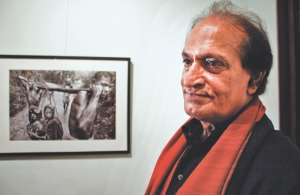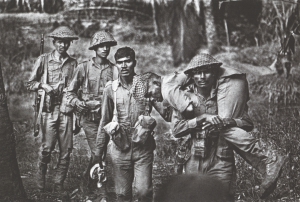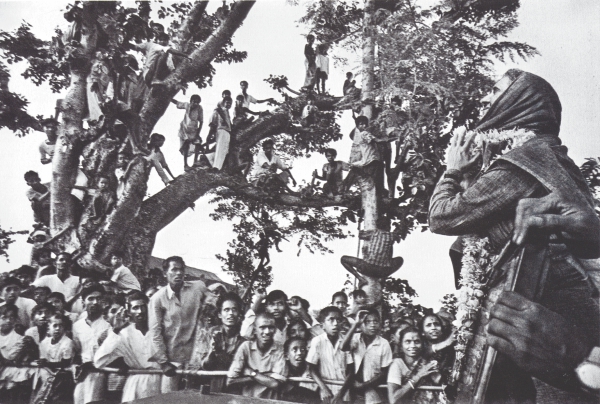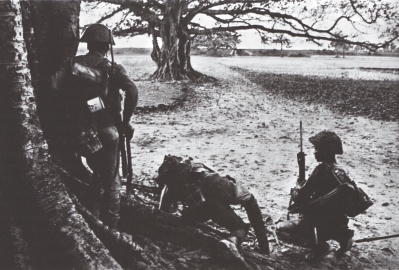| Home - Back Issues - The Team - Contact Us |
 |
| Volume 11 |Issue 49| December 14, 2012 | |
|
|
Photography
The Red Badge of Courage FAYZA HAQ
As a photographer in the Statesman, still in his twenties, in 1971 Raghu Rai was assigned to cover Bangladesh's Liberation War. He had lost the negatives of that memorable assignment many years ago, and found them only recently. Having written 30 books, the photographer, who was given the Padmashree award by the Indian government, decided that he should have an exhibition of his black and white prints on '71. Raghu has won awards even on an international basis. The photos reveal the pain and ecstasy of the freedom movement of the Muktijoddhas– the women and children who had suffered during the mindless pillage of the Pakistan Army, who burnt and raped being guided by the Army chief, Yahya Khan. This maniacal madness can only be compared to the heartless massacre of the Jews during the World War, by Hitler and his forces. The photos put up by Raghu Rai at Bengal Gallery were indeed awe-inspiring. His photographs show the refugees as overcome by sun and soaked in rain. He showed them tramping, on bullock carts—tired and suffering. He depicts, through his images, the overflowing mass of refugees, seeking shelter, eyes full of tears, uncertain of the future, as they were crossing over to India with their horrific tale of holocaust, misery and pain. With long limbs, a tapering figure, swathed in a magenta scarf and dramatic black kurta, Ragu Rai, in his soft voice, says, “When you see an old lady suffering and crying, you think it could be your mother. Every emotion and suffering mattered to me. It was such a gigantic exodus with thousands of people turning up everyday at Calcutta and other parts of the Indian border. It was a very sad story to shoot. When little children cried your heart cried with them.”
Asked what satisfied him professionally, he says, “Every emotion of every age becomes precious to one. Can you say that your suffering is greater than that of his or mine? The suffering was common to all of them. They had the same tragedy. They were being killed; they were thrown out of their own homes.” There are photos with bare backed men, covered with sweat, carrying the woman, head covered with her belongings. Behind them comes another bare bodied refugee with his “lungi” hitched up –carrying a child. A fleeing old couple, perhaps in their 70s or 80s, are seen with a supporting bamboo pole, a “dekchi” hung by a rope and the bedding. The growing paddy and coconut trees appear in the backdrop of this tale of tragedy. A seated woman, with glazed eyes is seen taking shelter under a tin of corrugated sheet. Meanwhile another pensive woman looks away.
A woman cooks on a smoking cauldron while a line of bare-bodied teenagers– all with spindly limbs, and shrunken bodies look on. Similarly, there is the shot of the thin old man with the bent old wife leaning on a pole for support. The woman, with her face partially covered, has the look of abject humiliation. The close-up of the woman as old as the hills, shows only wrinkles to tell of her misery and hopelessness. Trouble and strife are the fate of the grandmother– who should be resting in the last years of her life. Men and women –sparsely clad, clearing the forest—is yet another image of optimism among the “has beens”. The soldiers with cannon fodder speak of the battlefield. “The Surrender” speaks of the humiliation on the face of the Pakistani General and the look of satisfaction of the Indian Army leaders—with their turbans and caps, along with badges and other decorations. Bangabandhu's return to Bangladesh in 1972 is a marvel in panorama. Indira Gandhi, garlanded, and waving out to the people of Bangladesh are images of crowing victory and contentment. Rai has talked about the Pakistani soldiers, who had come with their US-supplied guns, and misinformation, such as there was no “azaan” in East Bengal. The soldiers were not aware that they were attacking their own Muslim brothers –though they spoke a different language—and wanted a homeland of their own. “When Muslims recently sent terrorists to India, saying that they were massacring Hindus, it was a similar situation. We all belong to the Indian Subcontinent; the cruelty is done to your own people. When I found the negatives, I decided to do the book on the freedom of a country about 18 months back. It is called Bangladesh: The Price of Freedom. 'Muktibahinis'– as the picture tells you, carried old rifles, they rode on a rickshaw – and yet they were ready to fight a tyrannical army. In shorts and sleeveless singlets even in the cold weather, covered only with old kanthas." True, the flag of Bangladesh in the photograph in the press conference room was a little lopsided, and the Bangladesh fighters rode a rickshaw, while at the side was a bulldozer, which was clearing the way for the Muktibahani – but their spirit had a grandeur that overpowered everything else. What was going on in his mind when he saw the Muktijoddhas? Raghu Rai says, “They were ill-equipped, and not trained at all. They couldn't have matched the Pak Army, who were equipped with US weapons. But the fact is that their spirit and determination were admirable by all standards. Without proper training and regular rifles, they had all the courage in the world. The element of sacrifice was very important and even incredible.” Did he follow up their movement from one village to another? They travelled by buses, rickshaws and of course by boats and launches. What was his impression about the Muktibahinis getting together and fighting against a far more powerful enemy? "Religion-wise the Pakistanis and the Freedom Fighters were brethren. They were both Muslims and worshipped the same monotheistic God of David, Moses and Jesus."
One of the memories that Raghu finds particularly painful are those of the women who became victims of rape and other forms of torture. “You look at their eyes and you could see they did not want to confront the male sex. After the violent carnage, the raped women were not ready to face the world, dominated by the male sex. Women of Bangladesh felt hopeless and useless,” says Raghu Rai, his voice trembling with pain and sorrow. How would he compare the carnage and the death of millions with the holocaust in Germany? "The Jews were assaulted by the Christians as happened in Europe, in the Middle Ages, while others looked the other way. This included the people in the highest order of the Christians. The Jews didn't know where to run for shelter," Raghu says, “ Hitler was a tyrant. Everybody knows that. Hitler and his followers believed that they were the most superior race, as they were Aryans. Jews were like vermin that they were trying to kill. In gas chambers, in concentration camps Jews were reduced to skin and skeletons. They were homeless and had nowhere to go. But East Pakistan and West Pakistan were the same country, just as India was undivided before the Partition. They were Muslim brethren, with the same religion. This was just because they wanted respect and certain kind of value system, as a Bengali culture—and their Pakistani counterparts could not bear that." Raghu Rai's photo essays have appeared in many of the world's leading magazines, including Time, Life, GEO, Le Figaro, Le Monde, Vogue, Newsweek, Marie Claire etc. He has written 30 books. He has written on Wild Life Management for National Geographic. He has been a judge for world photo contests as for Amsterdam and UNESCO. He has done extensive work on the 1984 Bhopal tragedy and its continued effect on the victims.
|
||||||||||||||||||||
Copyright
(R) thedailystar.net 2012 |






